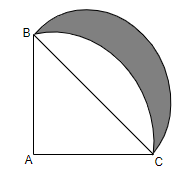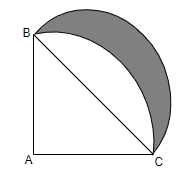
In the following figure $ABC$ is a quadrant of a circle of radius 14cm and a semicircle is drawn with $BC$ as diameter. Find the area of the shaded region.


Answer
567.3k+ views
Hint: At first find out the length of $BC$ by using Pythagoras theorem. Then find out the area of the triangle and area of the quadrant. Find out the area of the semicircle. Lastly subtract the area of the non shaded part of the semicircle from the area of the semicircle to get the area of the shaded part.
Complete step-by-step answer:
Let us take the figure first-

We have to find out the area of the shaded region. Now if we look at the figure very carefully,
The area of the shaded region = area of the semicircle – area of the non shaded part of the semicircle.
To find out the area of the semicircle we need to find out the length of $BC$ , the diameter of the semicircle.
We can clearly see that $BC$ is the hypotenuse of the right angle triangle $ABC$ .
So, we can use Pythagoras theorem, that is:
$B{{C}^{2}}=A{{B}^{2}}+A{{C}^{2}}$ , as $AB,BC$ are the radius of the circle $AB=AC=14cm$ .
$\begin{align}
& \Rightarrow B{{C}^{2}}={{14}^{2}}+{{14}^{2}} \\
& \Rightarrow B{{C}^{2}}=196+196 \\
& \Rightarrow B{{C}^{2}}=392 \\
& \Rightarrow BC=\sqrt{392}cm \\
\end{align}$
$BC$ is the diameter of the semicircle. So the radius of the semicircle is $\dfrac{BC}{2}$ .
That is $\dfrac{\sqrt{392}}{2}cm$ .
Area of the semicircle is:
$=\dfrac{1}{2}\times \pi {{r}^{2}}$ , r is the radius of the semicircle. Let us put $\pi =\dfrac{22}{7}$ .
$\begin{align}
& =\dfrac{1}{2}\times \dfrac{22}{7}\times {{\left( \dfrac{\sqrt{392}}{2} \right)}^{2}} \\
& =\dfrac{11}{7}\times \dfrac{392}{4}=\dfrac{11\times 56}{4}=11\times 14=154c{{m}^{2}} \\
\end{align}$
Now$ABC$ is a quadrant of a circle of radius 14.
We know that the area of quadrant of a circle is:
$=\dfrac{1}{4}\times \pi {{r}^{2}}$ , r is the radius of the circle.
$=\dfrac{1}{4}\times \pi \times {{14}^{2}}$
Put, $\pi =\dfrac{22}{7}$
$\begin{align}
& =\dfrac{1}{4}\times \dfrac{22}{7}\times 14\times 14=154c{{m}^{2}} \\
& \\
\end{align}$
We know that area of a right angle triangle is = $\dfrac{1}{2}\times base\times height$
Here base is $AC$ , height is $AB$ .
So the area of the triangle is:
$=\dfrac{1}{2}\times 14\times 14=7\times 14=98c{{m}^{2}}$
Area of the non shaded part of the semicircle = area of the quadrant of the circle – area of the right angle triangle.
$\begin{align}
& =\left( 154-98 \right)c{{m}^{2}} \\
& =56c{{m}^{2}} \\
\end{align}$
Now we have the area of the semicircle and the area of the non shaded part of the semicircle.
So the area of the shaded region is = area of the semicircle – area of the non shaded part of the semicircle.
$=154-56=98c{{m}^{2}}$
Therefore the area of the shaded portion is $98c{{m}^{2}}$ .
Note: Here we have to remember the formula of area of a right angle triangle.
If we know the formula of the area of a circle we can easily calculate the area of the quadrant of a circle.
Area of the quadrant of a circle is $\dfrac{1}{4}\times \pi {{r}^{2}}$ , r is the radius of the circle.
Area of a semicircle or we can say half of the circle is $\dfrac{1}{2}\times \pi {{r}^{2}}$ .
Complete step-by-step answer:
Let us take the figure first-

We have to find out the area of the shaded region. Now if we look at the figure very carefully,
The area of the shaded region = area of the semicircle – area of the non shaded part of the semicircle.
To find out the area of the semicircle we need to find out the length of $BC$ , the diameter of the semicircle.
We can clearly see that $BC$ is the hypotenuse of the right angle triangle $ABC$ .
So, we can use Pythagoras theorem, that is:
$B{{C}^{2}}=A{{B}^{2}}+A{{C}^{2}}$ , as $AB,BC$ are the radius of the circle $AB=AC=14cm$ .
$\begin{align}
& \Rightarrow B{{C}^{2}}={{14}^{2}}+{{14}^{2}} \\
& \Rightarrow B{{C}^{2}}=196+196 \\
& \Rightarrow B{{C}^{2}}=392 \\
& \Rightarrow BC=\sqrt{392}cm \\
\end{align}$
$BC$ is the diameter of the semicircle. So the radius of the semicircle is $\dfrac{BC}{2}$ .
That is $\dfrac{\sqrt{392}}{2}cm$ .
Area of the semicircle is:
$=\dfrac{1}{2}\times \pi {{r}^{2}}$ , r is the radius of the semicircle. Let us put $\pi =\dfrac{22}{7}$ .
$\begin{align}
& =\dfrac{1}{2}\times \dfrac{22}{7}\times {{\left( \dfrac{\sqrt{392}}{2} \right)}^{2}} \\
& =\dfrac{11}{7}\times \dfrac{392}{4}=\dfrac{11\times 56}{4}=11\times 14=154c{{m}^{2}} \\
\end{align}$
Now$ABC$ is a quadrant of a circle of radius 14.
We know that the area of quadrant of a circle is:
$=\dfrac{1}{4}\times \pi {{r}^{2}}$ , r is the radius of the circle.
$=\dfrac{1}{4}\times \pi \times {{14}^{2}}$
Put, $\pi =\dfrac{22}{7}$
$\begin{align}
& =\dfrac{1}{4}\times \dfrac{22}{7}\times 14\times 14=154c{{m}^{2}} \\
& \\
\end{align}$
We know that area of a right angle triangle is = $\dfrac{1}{2}\times base\times height$
Here base is $AC$ , height is $AB$ .
So the area of the triangle is:
$=\dfrac{1}{2}\times 14\times 14=7\times 14=98c{{m}^{2}}$
Area of the non shaded part of the semicircle = area of the quadrant of the circle – area of the right angle triangle.
$\begin{align}
& =\left( 154-98 \right)c{{m}^{2}} \\
& =56c{{m}^{2}} \\
\end{align}$
Now we have the area of the semicircle and the area of the non shaded part of the semicircle.
So the area of the shaded region is = area of the semicircle – area of the non shaded part of the semicircle.
$=154-56=98c{{m}^{2}}$
Therefore the area of the shaded portion is $98c{{m}^{2}}$ .
Note: Here we have to remember the formula of area of a right angle triangle.
If we know the formula of the area of a circle we can easily calculate the area of the quadrant of a circle.
Area of the quadrant of a circle is $\dfrac{1}{4}\times \pi {{r}^{2}}$ , r is the radius of the circle.
Area of a semicircle or we can say half of the circle is $\dfrac{1}{2}\times \pi {{r}^{2}}$ .
Recently Updated Pages
How do you convert r6sec theta into Cartesian form class 10 maths CBSE

How do you solve dfrac5y3dfracy+72y6+1 and find any class 10 maths CBSE

If sin A+B1 and cos AB1 0circ le left A+B rightle 90circ class 10 maths CBSE

On the number line 10 is to the of zero class 10 maths CBSE

How do you solve 5xge 30 class 10 maths CBSE

In the following sentence supply a verb in agreement class 10 english CBSE

Trending doubts
Write an application to the principal requesting five class 10 english CBSE

Why is there a time difference of about 5 hours between class 10 social science CBSE

Write a letter to the principal requesting him to grant class 10 english CBSE

The Equation xxx + 2 is Satisfied when x is Equal to Class 10 Maths

What is the median of the first 10 natural numbers class 10 maths CBSE

Write examples of herbivores carnivores and omnivo class 10 biology CBSE




